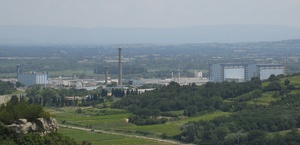
New Managing Director for Bellona Norway
The Board of the Bellona Foundation has appointed former Minister of Climate and the Environment Sveinung Rotevatn as Managing Director of Bellona No...
News

Publish date: September 14, 2011
Written by: Charles Digges
News
Ministers said the blast, at the Marcoule nuclear site, near Avignon and Nimes, was an “industrial accident” and not an explosion in, or near, a nuclear reactor. There was no radioactive leak and no need to evacuate workers or local people.
The explosion at the sprawling Marcoule site on the banks of the Rhône – one of the oldest and largest nuclear facilities in France – is nonetheless a political and economic embarrassment to the French government.
Officials said that Monday’s explosion had occurred in an oven used to destroy or recycle weakly radioactive objects ranging from metal bars to tools and gloves. The oven was a part of the Marcoule site’s Centralco waste disposal facility, which became operational in 1999.
The French Nuclear Safety Authority has said that radiation detectors around the site have detected no radiation leaks.
But a the overwhelming majority of incidents at the Centralco facility reported over the last eight years have received a ranking on the seven-point International Nuclear Event Scale (INES). Level “1,” which is what the incidents at Centralco were assigned, rank as “anomalies.”
Only Chernobyl and Fukushima have ever achieved the INES’s highest rating of Level “7.” The accident that the Three Mile Island plant in the US state of Pennsylvania ranked a Level “5” on the INES scale.
Centralco’s shaky swerves onto the INES scale, however, has environmentalists jittery.
“History shows that there is a need for a thorough review of [Marcoule] and other French nuclear sites. This is both because of the explosion Monday and in light of the Fukushima accident in Japan earlier this year,” said Bellona nuclear physicist Nils Bøhmer.
Since the calamity at the Fukushima plant in Japan in March, France – like Russia and the United States – has been at pains to reassure its citizens, and potential foreign buyers, of the safety of its own nuclear technology, even as other European heavyweights are dropping out of the game.
Germany says it will shut down all of its nuclear plants by 2022, Switzerland by 2035 and Italy – the G8’s only non-nuclear powered nation, voted in a referendum last summer against even beginning with nuclear power.
Environmental groups are not positive that the French government – which famously declared in 1986 that the radioactive nuclear cloud from the Chernobyl explosion in the Ukraine had “stopped at the French frontier” – is up to the task of conducting a thorough review of Monday’s tragedy.
France Nature Environnement (FNE), which has 3,000 member associations, said in a statement that the accident “underlines the problems with control of nuclear risks in France”. The significance of nuclear accidents has sometimes been obscured by French authorities in the past, FNE pointed out.
The group has called for “total transparency” and an independent investigation.
According to Bellona’s Bøhmer, what is has been made public by the French Nuclear Safety Authority about operations at the Centralco facility is reason for pause.
In May 25th of this year, a periodic test of fire detectors at the Centralco facility led to a system failure, and the detection system was temporarily unusable, during which workers in high radiation exposure areas had to cease work, and patrols were established to measure radiation.
The system only came back online four days later after central parts of the fire alarm were replaced. The French Nuclear Safety Authority ranked the events as a “1” or “anomaly” on the seven point International Nuclear Event Scale (INES). Only Chernobyl and Fukushima have ever rated a “7” on the scale.
On August 15 2010, an incinerator at Centralco suffered 4-hour and ten minute power loss, stopping the feeding of solid and liquid material into the furnace. The power problems led to the discovery of radioactivity in the exhaust pipes. The incident was classified at a “1” on the INES scale by the Nuclear Safety Authority.
On December 17 2007, high levels of tritium that exceeded annual tritium release levels by 10 percent were detected and led to a shut down of part of the facility for a year. The French Nuclear Safety Authority requested an analysis of the incident from Centralco and a list of corrective measures to be taken.
In 2007, the Centralco facility has two incidents that ranked a “1” on the INES scale, one having to do with receiving a barrel of liquid waste for disposal that exceeded radiation limits. Later that year a ventilation system broke down during maintenance work and alarm systems failed to work, which would have alterted workers to mandatorily evacuate. A similar alarm failure occurred in 2005.
And in 2003 another Level “1” event on the INES scale occurred when a fire broke out. The fire was traced to non-permissible substances shipped with waste for disposal to the plant.
Andreas Steenbuch Mathismoen contributed to this report.

The Board of the Bellona Foundation has appointed former Minister of Climate and the Environment Sveinung Rotevatn as Managing Director of Bellona No...

Økokrim, Norway’s authority for investigating and prosecuting economic and environmental crime, has imposed a record fine on Equinor following a comp...

Our op-ed originally appeared in The Moscow Times. For more than three decades, Russia has been burdened with the remains of the Soviet ...

The United Nation’s COP30 global climate negotiations in Belém, Brazil ended this weekend with a watered-down resolution that failed to halt deforest...